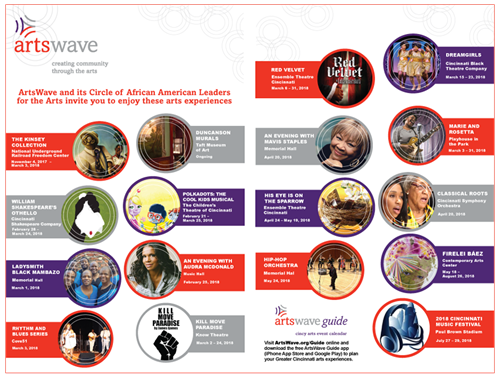posted by Kathy DeBrosse ON
Mar 23, 2018

The arts make a difference in our region that takes form in two outcomes: they connect every one of us as human beings, and together, the arts propel our economy.
The concept of connection is underscored by national research conducted by American for the Arts, which reports that 67% of Americans believe “the arts unify our communities regardless of age, race, and ethnicity” and 62% agree that the arts “helps me understand other cultures better” — a perspective observed across all demographic and economic categories.
Cincinnatians agree, and in comparison, they may be more convinced of the arts’ ability to connect the region. In the latest Greater Cincinnati Survey, conducted this past winter by the institute for Policy Research at University of Cincinnati, 89% percent of regional residents believe that arts programs and events bring people together in the Greater Cincinnati region.
While the statistics are impressive, the idea of the arts connecting us is important. It’s through this bond of shared experiences that we see our differences not as barriers but instead, as unique, valued attributes that together make us stronger. As companies decide to start and locate businesses here and those businesses work to retain their employees, varied opportunities for shared arts experiences become a competitive advantage. Employers equally can use the arts as the vehicle for increasing cultural competencies as part of their diversity and inclusion initiatives.
Bridging cultural divides is one of five components a part of the Blueprint for Collective Action, a 10-year plan that ArtsWave, the planner, promoter and fundraiser of the arts, created with and for the sector in 2015.
Recently, ArtsWave presented a performance of “Marie and Rosetta” at Cincinnati Playhouse in the Park. This production tells the story of Sister Rosetta Tharpe and her friend and business partner Marie Knight. These two women working in the 1960s were pioneers for their time, staying overnight in funeral homes because, through Jim Crow laws, black women weren’t allowed to stay in hotels. Not only were they thinking creatively to survive, but Tharpe and Knight were infusing gospel music with the earliest forms of rock and roll that later on got picked up by artists, including Elvis Presley, Chuck Berry, and Jerry Lee Lewis. Taking church music, threading it with jazz and adding an electric guitar was groundbreaking on many levels. But skilled actresses and musicians telling the story in a theatrical setting can make an audience of strangers understand and empathize in a profound way.
Beyond the storyline, the crowd was equally inspiring — a mix of every demographic possible coming together in a shared experience. This is exactly what ArtsWave strives to do: bridge cultural divides through shared arts experiences so that everyone in the community feels connected.

ArtsWave has created a variety of networking and communication groups, including a Circle for African American Leaders for the Arts. Every quarter, for instance, we create a calendar of arts experiences happening throughout the region over the next few months that particularly reflect or celebrate the African American experience. Besides “Marie and Rosetta,” this current roundup of events includes shows like "Polkadots: The Cool Kids Musical," in which The Children’s Theatre of Cincinnati brings to life an eight-year-old girl’s journey to integrate in a “squares only” small town; and the Cincinnati Black Theatre Company’s dynamic adaptation of the ever-popular musical, Dreamgirls.
ArtsWave is committed to sharing these and other experiences regularly, believing that amplifying what’s happening throughout the region will lead to greater interaction, understanding and, ultimately, appreciation for our differences along with a greater sense of our common humanity.